Paintings of Judith in the Bible
Hidden meanings in paintings of Judith
- Watch for symbolic colors in the paintings: red ways sexual passion; white is purity of behaviour or intent; gold is nobility;
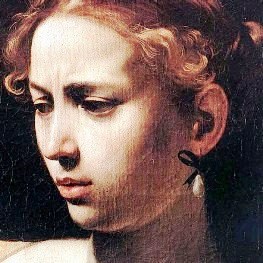 black is the color of death.
black is the color of death. - The first paintings of Judith, produced in the Middle Ages, showed virtue overcoming vice.
- During the Renaissance a different theme emerged: Judith was an case of Homo'southward misfortunes at the hands of scheming Woman.
- The decapitation of Holofernes has sexual overtones: a homo is robbed of his virility by a beautiful woman.
- In fact, Judith was a Jewish patriotic heroine and a symbol of the Jews' struggle against their aboriginal, more powerful, overlords.
'Judith with the Caput of Holofernes', Lucas Cranach, 1530
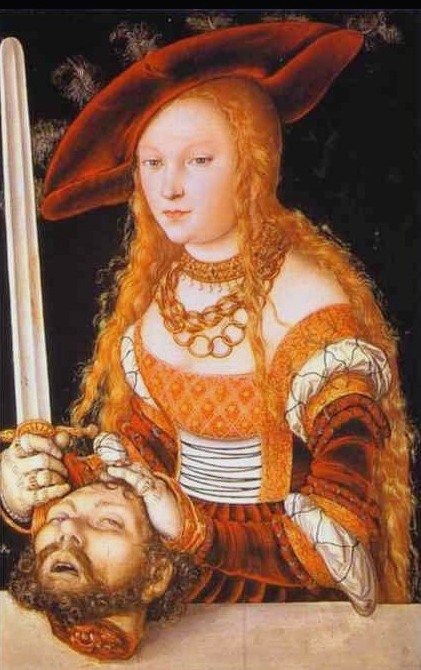
Judith's right hand holds the sword, instrument of death. The fingers of her left hand are entwined in Holofernes' pilus, as she toys in an absent-minded way with the lifeless caput.
If you are looking for subtlety, walk on by. Cranach the Elder is non your human being.
But if you value a strong, no-nonsense bulletin about God, organized religion and conservancy, you may want to look more advisedly at Cranach'due south work.
Cranach was a shut friend of Martin Luther (the famous portrait of Luther is by Cranach), and helped promote his ideas – he was a staunch supporter of the Protestant Reformation.
The story of Judith struck a chord with the Protestant reformers, since it described the courage of a small nation resisting a tyrant from exterior who sought to impose his own beliefs about God on them.
The Protestant states bandage themselves as Judith, and Catholicism and the Pope equally Holofernes.
There was also an attempt at this fourth dimension to balance the preponderance of male heroes in Christian tradition with biblical heroines who could exist role models of particular virtues.
Cranach'southward paintings are always beautiful (as God is) but evil lurks simply beneath the surface.
See the Bible text for this story
'Judith and Holofernes', Gustav Klimt, 1901-2
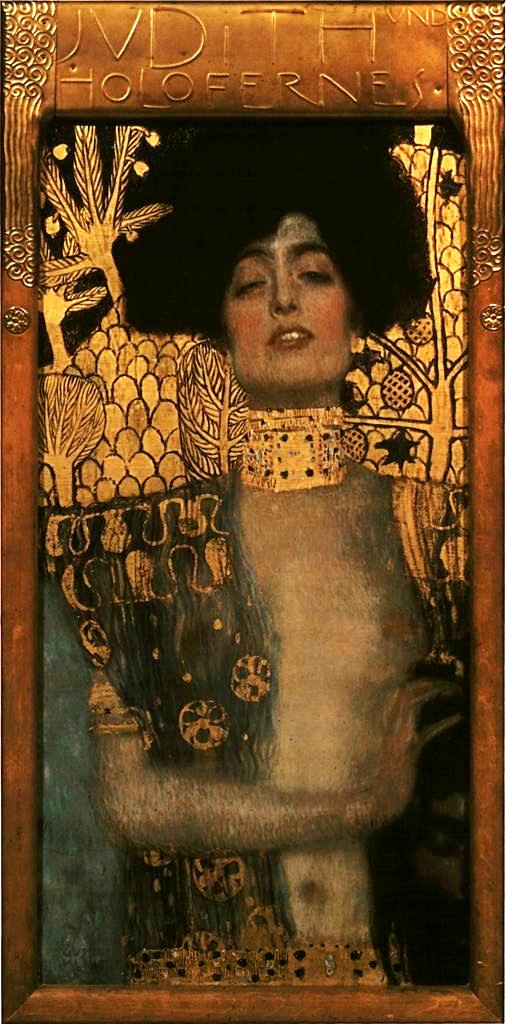
Judith is dressed in the rich clothing and lavish jewellery she wore when she went to run into Holofernes. She is a woman of golden.
Does the oversized gilt choker at her neck suggest decapitation? Her vesture is disarrayed, just her look is triumphant as she holds the head of her enemy by her side.
At that place are similarities between this Art Nouveau painting and Byzantine icons: both make lavish use of gold leaf, both depict female heroines in elongated form.
The gilded-leaf landscape behind her, with laden palm trees, is reminiscent of ancient Assyrian wall drawings of the Tree of Life.
And is that a Star of David above her left shoulder?
Run across the Bible text for this story
Beheading Holofernes
'Judith Beheading Holofernes', Caravaggio, 1599
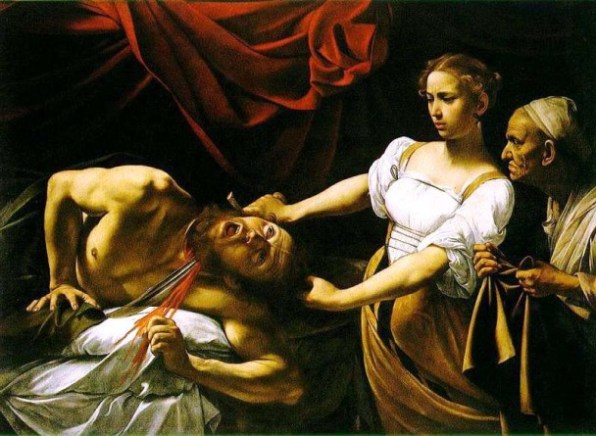
Judith has steeled herself to cut into Holofernes' neck, using his ain sword. 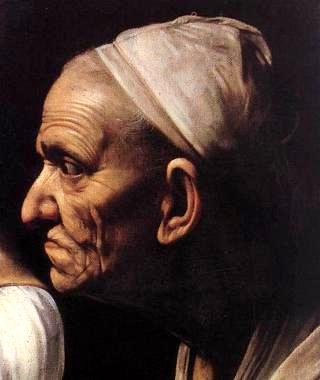
The maid Abra stands prepare to grab the severed caput when it falls away.
Abra is one of the nigh over-looked figures in the Old Testament; she is with Judith every pace of the way, and clearly gives her not just a servant's support, but a large measure of courage as well.
Caravaggio has painted a magnificent Holofernes, muscled, strong, powerful. His horrified face is the attention-grabbing focus of this picture.
Judith, on the other hand, slices his neck with a look of mild distaste, as if she is carving the Lord's day roast.
The colors, harmonious composition and shading of the painting are superb, equally nosotros would expect from Caravaggio.
But magnificent every bit the painting is, information technology does not convey the ghastly horror of the event.
Run into the Bible text for this story
'Judith and her Maidservant', Artemisia Gentileschi, 1613-14
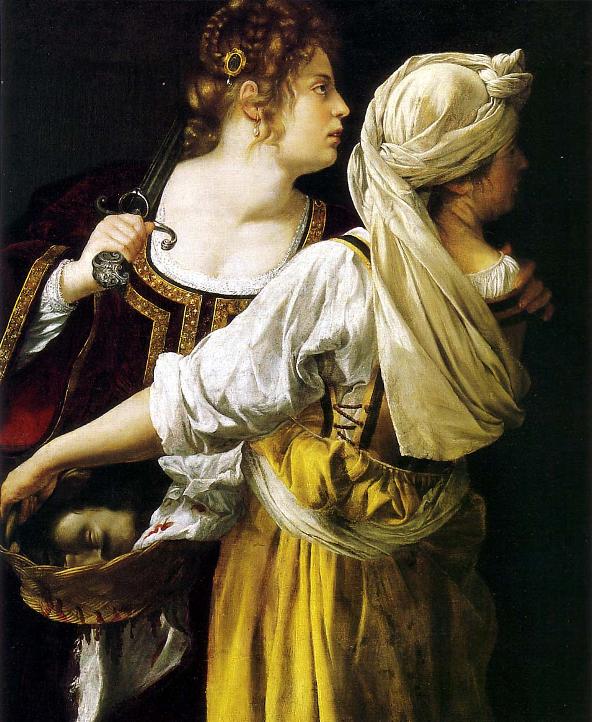
Judith's maid Abra has gathered up the head of Holofernes in a basket, and they are preparing to leave his tent when they hear something which makes them stop and listen.
The danger of their state of affairs is implied by the position of the sword in Judith'due south hand: a few more inches and it will cut into her own white throat.
Close-ups of the painting testify that the brooch in her hair is a picture of a warrior, perchance the biblical David who is the male person equivalent of Judith.
See the Bible text for this story
'Judith', Gustav Klimt, 1909

Judith stands, her fingers clenched in the pilus of Holofernes' head. Her gorgeous robe has fallen abroad from her body and her pilus is disarranged, only she seems calm, oblivious of her surroundings, well-nigh in shock.
This painting has oft been labeled 'Salome', because it depicts a half-naked woman carrying a man's severed head. In fact, the woman is Judith, not Salome.
Though it is an archetypal Art Nouveau painting, in that location are many similarities with Old Primary images of Judith: a remorseless, half-clothed adult female, disguised tension in the rigid easily, the sumptuous clothes.
See the Bible text for this story
'Judith with the Head of Holofernes', Carlo Saraceni, 1615-20
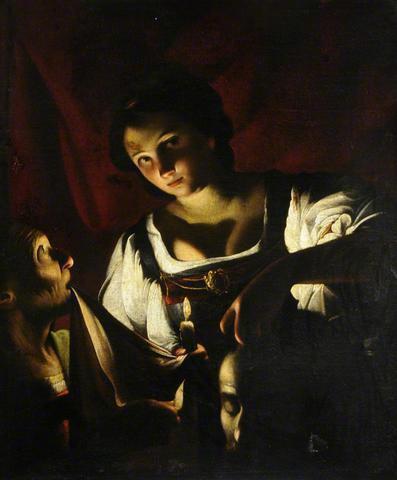
The maid's broken-hearted face looks up for reassurance to Judith, who despite the horror of the situation appears calm, almost serene. She holds the head of Holofernes in her left hand, prepare to drop it in the bag held by her maid.
The darkness of the painting suggests the secretive nature of what they are doing, the need for stealth.
In reality it is unlikely that Judith was every bit calm equally she appears in this film, just there is an unexpected impact of realism in the way the maid holds the bag. She grips one indicate between her teeth and makes an opening by holding ii other points with her easily – but the way you would to make an opening for a large round object, be information technology a cabbage or a human head.
There are only subtle indications of the violent murder that has just occurred: the reddened fingers that hold Holofernes' head, and the spatter of blood on Judith'due south right temple. Subtle, but terrifying.
See the Bible text for this story
'Judith and her Maidservant with the Caput of Holofernes'
Orazio Gentileschi, (father of Artemisia), 1610-12
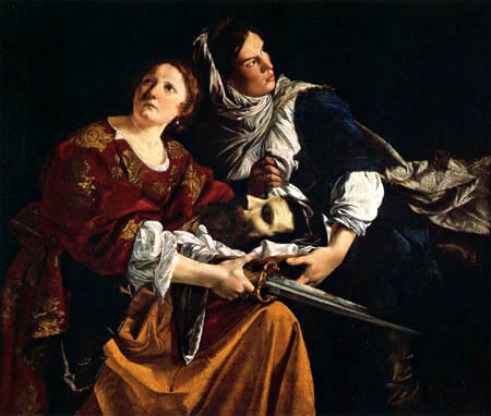
The deed is done – Judith still holds the sword in her hand. At present the fearful women stop to mind, to run across if an warning has been raised.
Orazio Gentileschi seems to have been more interested in the woman themselves than in the violent criminal offence they had committed. These two women are non arcadian beauties only existent people, both with their ain personalities and agendas.
This makes the painting sharply different from many of the others completed at that fourth dimension, and may have something to practice with the rape of his daughter Artemisia Gentileschi.
Artemisia was a real person to her begetter, not just an unnamed victim of crime.
See the Bible text for this story
'Judith in the Tent of Holofernes', Johann Liss, 1622
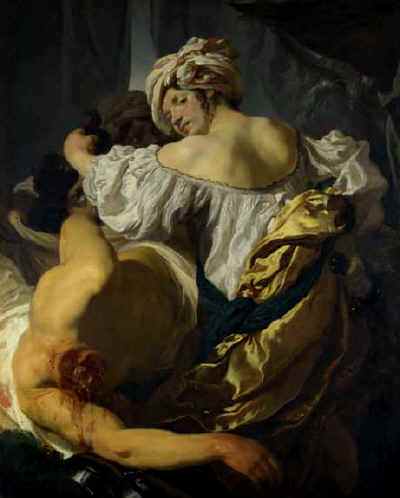
Judith has cutting off the caput of Holofernes and looks back over her shoulder, out towards the viewer. Her expression is strange – dazed, almost detached. She and her servant Alba are placing the severed head in a basket.
Caravaggio's influence is clearly axiomatic in Liss'due south painting – the sumptuous flesh tones, lavish fabrics and dramatic lighting. The twisted gold fabric draws the centre up towards Judith'due south naked back and the ambiguous glance she casts over her shoulder.
Holofernes' hapless body pushes out into the foreground of the painting.
An unusual feature of the painting: Judith's retainer Abra is African, non Jewish as you might expect.
See the Bible text for this story
'Judith Beheading Holofernes', Artemisia Gentileschi, circa1612
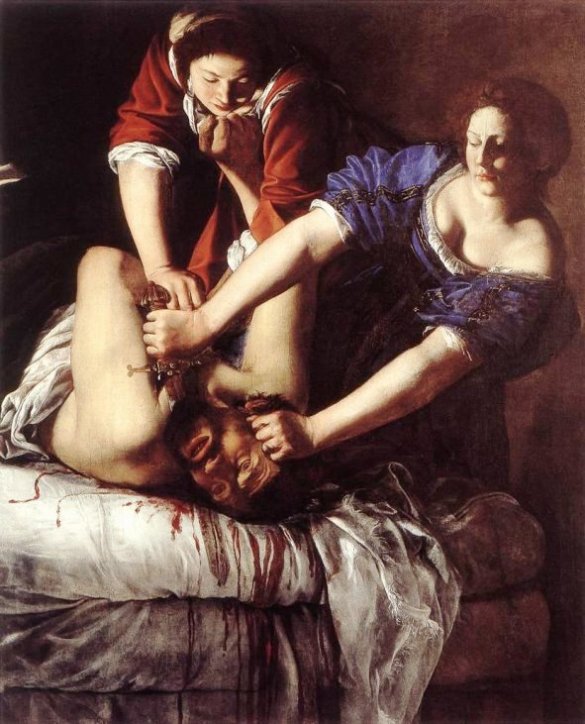
This is a rare depiction of something other paintings ignore: the fight that Holofernes may or may non have put up when he was existence murdered. Hither, in the moment of dying, he presses his correct hand up against his aggressor, attempting to fight her off.
Judith'due south torso seems to flinch away – from Holofernes? or from what she is doing? Both, perchance.
This painting was made at most the time that Artemisia Gentileschi was raped past her tutor, the Tuscan painter Agostino Tassi. At that place is obviously a certain amount of personal savor in the painting, with underlying themes of castration and impotency.
The story of Judith must take appealed to Gentileschi, depicting every bit it did the triumph of female person guile over male person force.
Run into the Bible text for this story
'Judith and the head of Holofernes', Giovanni Baglione, 1608
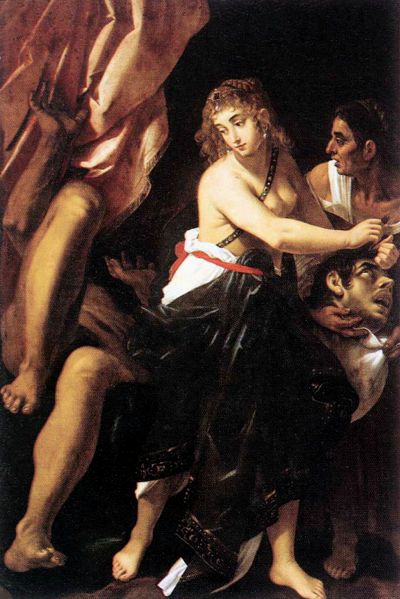
The body of Holofernes, now separated from his head, seems to writhe in its decease throes. A rather winsome Judith has grasped the caput by its hair and is moving away from the couch. Her maid looks back in horror at the body.
Dissimilarity this image with Caravaggio's (above). Judith seems remarkably tranquil in the circumstances, while her maid registers shock and horror.
But note in particular the different treatment of Holofernes' body. Here in Baglione's painting the body itself is almost hidden. What we can see of it is distorted and writhing, the head quite separate from the body – altogether, a figure of horror.
Meet the Bible text for this story
'Judith and her Maidservant With the Caput of Holofernes'
Artemisia Gentileschi, circa 1625
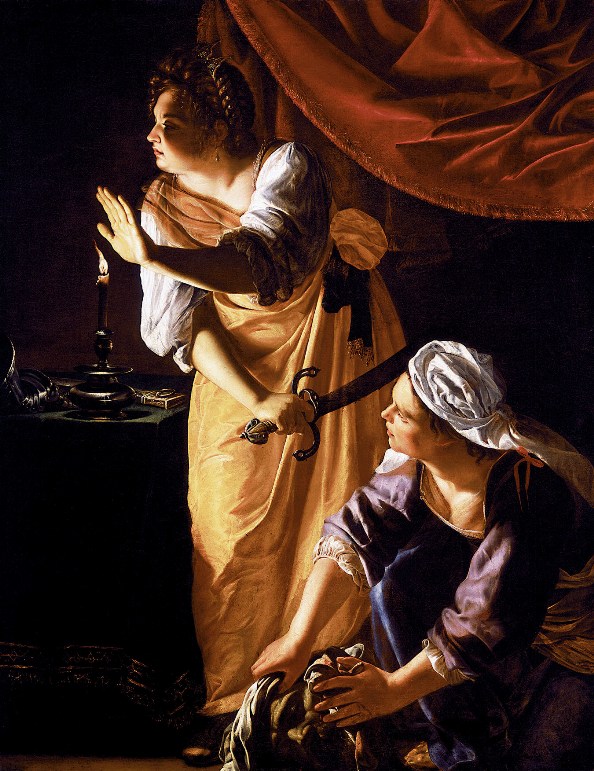
Judith has killed Holofernes, and now her maid Abra crams the bloody head into a sack, to carry it dorsum to Bethuliah. But they seem to have heard something, and interruption, waiting to see if they take been discovered.
If they have, they know they will die as well.
The tension of the scene is almost palpable. Danger is shut as Judith and her maid Abra get together upwards the severed head of Holofernes, preparing to flee from the enemy camp, back to safe in Bethulia. The light and shadow emphasise the imminent danger as Judith and Abra prepare to abscond Holofernes'southward tent with his severed caput.
We tin can almost smell and feel their fearfulness.
See the Bible text for this story
'Judith with the caput of Holofernes', Cristofano Allori, 1613
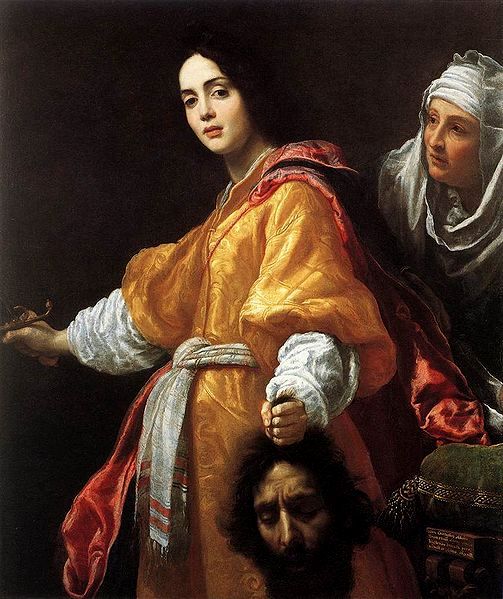
Judith has hacked off the head of Holofernes and now puts abroad the sword she used to practise the deed. Her maid Abra leans anxiously towards her, protectively, urging the dazed Judith to motion with more speed.
The head of Holofernes is said to be a portrait of the artist, and the woman in the picture was modeled on his mistress, a famous beauty chosen Mazzafirra.
Perchance the painting is a comment on the balance of ability within their ain human relationship – she having conquered him and now belongings him helpless in her grip. His confront is already drained of color, a dramatic dissimilarity to the rich material of her robe.
Meet the Bible text for this story
Judith with the caput of Holofernes, stained glass window
Diane-Blair Goodpasture, 2010
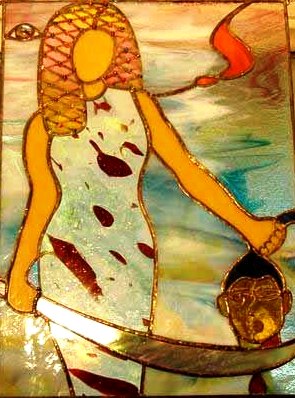
Judith holds the recently severed head of Holofernes by its hair. His sword, which she used to kill him, is smeared with his own blood. Her dress, too, is spattered.
An ignoble end for a famous warrior, killed past his own sword.
Judith is lavishly dressed, with a jewelled head-dress enclosing her thick hair. Compare the two faces: hers blank – with shock? His ghastly in death.
Behind Judith are two things: the omniscient centre of God, and the Hebrew alphabetic character 'yod' which is symbolic of the name of God – Marc Chagall uses this aforementioned device in his paintings.
See the Bible text for this story
'Judith with the head of Holofernes', Titian, circa 1515
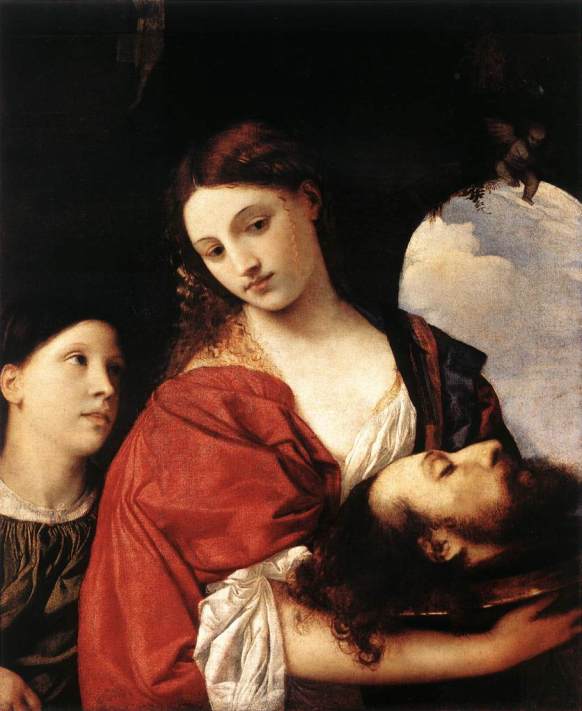
Judith has cut off the caput of the enemy general Holofernes, and now prepares to comport it back to the townspeople of Bethuliah.
At that place has been some argument nigh the identity of the adult female in this painting. The confusion arose because the decapitated caput is carried on a argent platter, traditionally the way that John the Baptist is depicted. This would and then make the woman Salome.
Only the adoring expression on the face of the second woman suggests that she is Abla, Judith's servant, and this seems more probable.
It is generally accepted at present that this is, in fact, a painting of Judith, done at the beginning of Titian'southward career.
See the Bible text for this story
'Judith', Vicenzo Catena, 1520
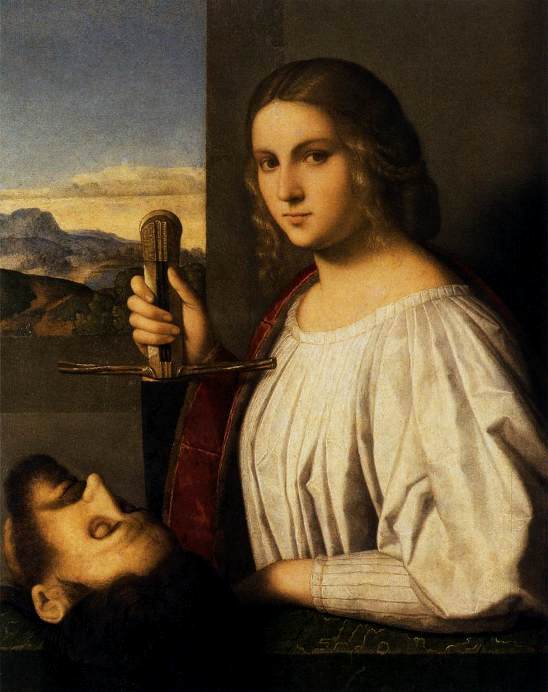
This painting of Judith is quite unlike to most others on the subject area. She is dressed in white, the color of chastity, and the sword stands firmly betwixt her body and Holofernes' caput.
The flick contains a message about her guiltlessness, which the Bible says she retained despite every effort on Holofernes' part to seduce her.
This is no seductress, but a adamant heroine.
See the Bible text for this story
Salve
Save
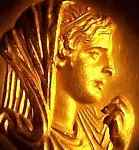
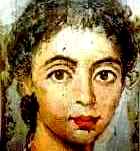
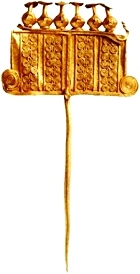



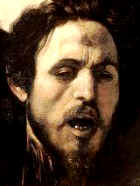
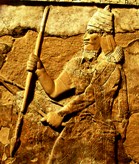
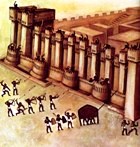


 black is the color of death.
black is the color of death. 















0 Response to "Medieval Art Cutting Off Head Painting of a Coffin"
Post a Comment